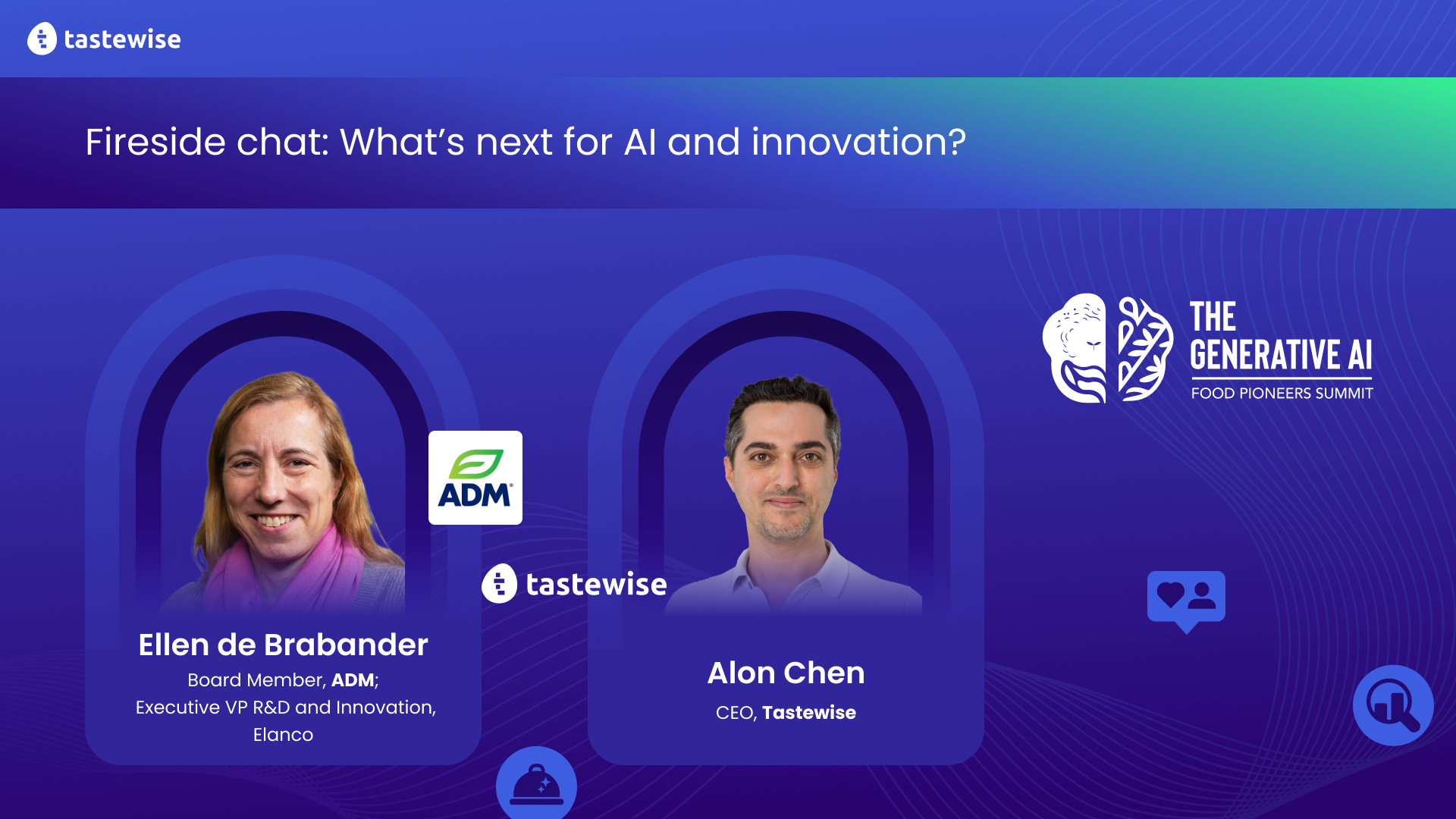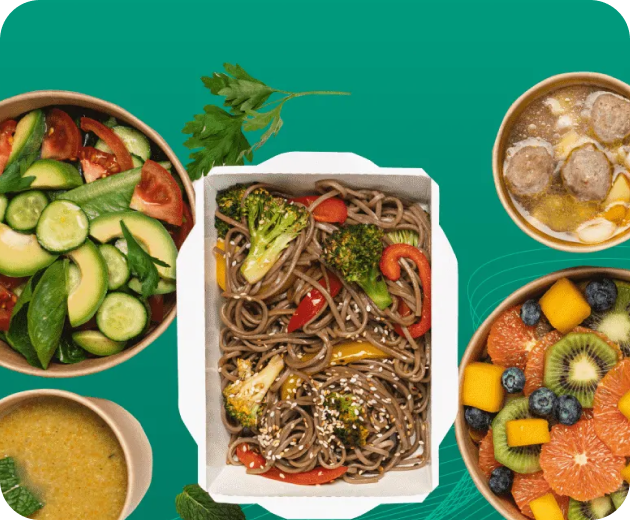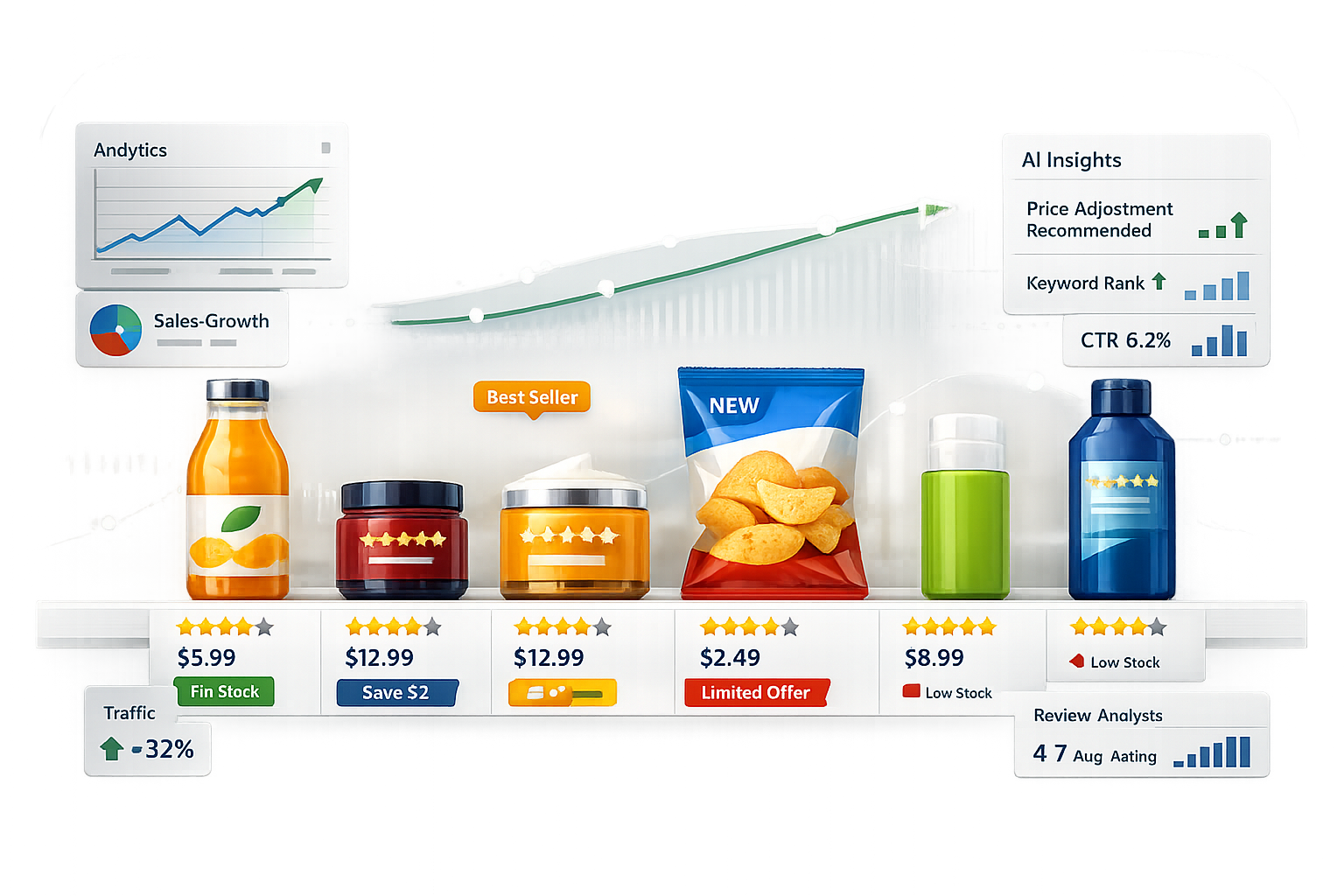Fireside chat: How can tech transformations shape R&D and product innovation?

Join Alon and Ellen as they explore groundbreaking advancements in AI technology transforming the food industry. This session dives into the innovative applications of generative AI, highlighting its potential to revolutionize food production, R&D and product innovation, enhance sustainability, and create personalized culinary experiences.
Alon Chen
CEO & Co-Founder, Tastewise
Ellen de Brabander
Board Member, ADM
[00:00:59]
Alon Chen: Hi, Ellen.
Ellen de Brabander: Hey, Alon. How are you? I’m doing fantastic and even better now having this opportunity to be talking to you today and share your wisdom with the broader food and beverage industry. Yeah. It’s been a while since we did meet and talk about this. So it will be good to do this again. Yeah.
Alon Chen: Absolutely. So Ellen you’ve been in the food and beverage industry for so long from your time in DSM at Pepsi Co and now both a board member at ADM and also at Elanco. And tell me, Ellen, given your experience in R and D, how do you see new technologies? Because this is really what keeps up us at night. Right? Like how can new technologies transform our development cycle in the food and beverage industry? And what is your take on it?
Ellen de Brabander: Yeah. Great question. And if you take a step back because product innovation it always should serve a
[00:02:00]
Ellen de Brabander: target, it’s always good to be clear okay what is it that you would like to achieve. And if you think about it actually what you need to achieve right now in order to meet the interest of the consumers that in the end need to consume your product, it’s quite different than say 10 years ago. I did write it down I think say 10 years ago. It was always important and it is always important to make sure you come as innovation where taste is good. Great tasting product was always important and it will stay important obviously. Quality. Food safety. There’s no debate that was important and will stay important. So there’s no compromise there. Cost was important. Accessibility was important. And yes. That is still important. The cost of course, especially now with higher inflation spaces, that is important. So these were requirements you always had to take in mind before you would start coming up with a new innovation in the food
[00:03:00]
Ellen de Brabander: or beverage space. But the interesting part is that yes that’s still important, but a couple of new requirements have come into play that also you need to keep in mind. And let me just mention three of those. One. I think we all are aware that people expect to be their food more nutrition. So more nutrition in the food instead of just great tasting is an important element. Especially a strong focus nowadays is of course on ESD, environment sustainability dimensions. And so and clearly there’s a strong role to play for the food space that it was something that we hardly did keep in mind 10 years ago or 20 years ago. Now it is front and center. How can we make sure that we innovate and come up with new products that actually have less impact on the society and on the environment? And the other element that you also see changing is there was a time where especially large organizations
[00:04:00]
Ellen de Brabander: really did benefit and they did well because they were basically benefiting from their size and their scale and their scope. And that did give them a huge advantage in terms of their rent and their cost and their reach. Now you see a trend that more and more actually the innovations are far less the one size fits all. That while that used to be a winning model, one size fits all as much as possible the same type of big innovations everywhere, that no longer is the case. That already has started say a couple years ago, but it is actually going further. It’s not just that you sub segment customers, but it’s also sub segment in terms of locations, all sorts of locations, certain countries obviously do want different innovations and different products have a different taste profile than others. And now you also see it during the year. You see innovations just linked to the Super Bowl or to Christmas or to-
[00:05:00]
Ellen de Brabander: so-certain moments in the year you also need to come with new innovation. So all in that of course brings additional complexity. Less scale. More complexity. And that is what you have to keep in mind if you are asked to come up with new product innovations.
Alon Chen: So what I’m hearing basically is you’re almost describing the perfect storm that happened in fashion like 10/15 years ago is now coming to the food industry where production is more complex. So basically sustainability and consumers moving shifting powers. But what you also give strong emphasis on is the competitive edge has changed completely leaving the space for a lot more competition to come in with different levers and different opportunities which makes it almost like the fast fashion disruption that happened
[00:06:00]
Alon Chen: a couple years ago and those that did not change ended up basically stayed behind. And those that adopted the production line speed, the time to consumer insight, the efficiency internally, has actually won the game. If I needed to narrow down a little bit into, you know, how do you see technology helping you cope with that? Because obviously the changes are coming as a result from a big technological change. Global awareness. Social media. Everyone is now an expert and an influencer. So how do you see what kind of technologies are going to transform the product development cycle?
Ellen de Brabander: The way product development was done in the past is not the way it can be done in the future. Because it is there’s way too many iterations before you come with a final product that actually does meet all the requirements with respect to taste and quality, food safety, cost, and now even
[00:07:00]
Ellen de Brabander: the new ones, as we discussed, the nutrition and environmental impact. So indeed it needs to be done in a different way. And in essence the two main changes that are needed are moving from trial and error as it used to be where we always those organizations would have one or two masters who had done many product innovations and they would basically define a little bit more of this, a little bit less of that. So that trial and error, you need to reduce that. You cannot completely eliminate it, but certainly less. The number of iterations you need before you say, “Yes this product can make it” is less. So moving much more to a data driven model approach. That is the important one.
[00:08:00]
Ellen de Brabander: And maybe in that respect let me give one example. It’s from a couple years ago, but still it’s very much telling. That was basically in the sports drink world where I think Gatorade clearly is the leading brand. And it always says backed by science and that was true. And one of the science conclusions always was in order to really support the athletes as sports you need six grams of sugar. So one of the Gatorade brand’s specialties was always we need six grams of sugar because that is what the athletes really need. And it was almost a no go to touch that. And in the meantime what you see is that many people like to consume Gatorade, but actually didn’t want to have the sugar because actually,
[00:09:00]
Ellen de Brabander: “You know, I’m running. I’m exercising. And actually I want to lose weight rather than drink in my sports drink more sugar.” So it did take a while before actually there was the decision was made, yes, let’s now make a Gatorade version without sugar. And that insight, that actually did take years. It sounds so obvious now that you say, “Yes. There will be a sub population that wants to have a sports drink without sugar.” And indeed it was not in line with the Gatorade brand guardrails, as you could see it. But once that decision was taken, and that insight was really understood, then indeed it was developed pretty quickly and Gatorade zero was really a massive success. So it’s one of those examples where you say, “If you really understand what is the need, how do people use a sport drink? Who are the users?” Not only the professional athletes who do need the six grams of sugar, but there is a massive other
[00:10:00]
Ellen de Brabander: consumer segment that wants to have a sport drink that actually, yes, does hydrate him, but there’s no need to add the sugar. So once that is then understood, yeah, then it’s not that complicated to come up with a good and great tasting sport drink without sugar. So it’s one of those examples that still sticks to me that actually became a real success based on a true insight. And I think we all have seen so many innovations where you say it’s not really rooted in true insight and then whatever A and M you use for that it will not solve it.
Alon Chen: Yeah. I love this example, and this is actually one of the first business decisions we made when this was started seven years ago was not to do brand monitoring and brand insights. We actually wanted to do category insights and general audience and consumer insight because we wanted to see what are the needs without
[00:11:00]
Alon Chen: getting the product managers attached to what they already are providing and their misconceptions. So basically have the data show what are the needs in the category and not necessarily say, “Oh. Here’s the needs for people that are already consuming your product.” And this is very difficult to do when you’re a brand manager because you have the misconception and the existing base that forced you to basically ask questions in your survey that you’re already doing, still doing that, in a way that actually the hypothesis is wrong. And so the questions you’re asking will lead you to the wrong answer. This was the second decision saying we don’t want to do that. We want to actually stay in a way that the data tells the story and not the user asked questions and then tell the story they’re expecting to hear. And that is actually was a big question. And in this context, Ellen, I have a question that is a little bit more
[00:12:00]
Alon Chen: specific because you mentioned quite a few times you mentioned the consumer insights and the importance. One of the concepts that we’re constantly thinking about is the democratization of data. And in our context it is the democratization of consumer data and consumer related insights. How do you think that the emergence of new technologies and the democratization of data, how do you think it will impact R and D specifically and how R and D is using insights? Or should they be using the insights or should they be relying on the marketers that give them the brief?
Ellen de Brabander: Yeah. Great question. That’s a question that always is front and center in many food and beverage organizations. And I think there’s broad consensus that, yes, this should not be done by silos. So clearly the insight people and the R and D people need to work together very
[00:13:00]
Ellen de Brabander: closely. But they both have their own responsibility where in essence within the R and D teams you have the responsibility for the products, the product characteristics. And the insight people really that is their role primarily of course to understand the trends and the questions behind the question. So what is the real need to really prevent that most innovations indeed don’t stick? I think every innovation that is launched that does not stick, it should almost be seen as a failure for the insight people. Say, “Why is this?” Or for the organization if you say, “Well, maybe it was not great tasting. The execution was not right.” But if the trend actually is just very temporarily a fad rather than something that will stick, it is that is really the role of the insight people where data of course need to play a big role. They say, “This will go away.” Or,
[00:14:00]
Ellen de Brabander: “We can make this stick.”
Alon Chen: Yeah. And also as you started, the pace of change today is so fast that you actually you have to make sure that your insight is actually not a fad. But on the other side you have to move fast. Right? So there is always the balance and the way I like to talk to my team about it is that you need to make sure that you have multi data that supports your evidence to be able to base your analysis. Think, “This is not going to go away because it addresses a deep consumer need that is not changing overnight because of a post on Instagram or Tik Tok.” And I want to take it and touch the most critical point. And you mentioned it before about the fact that organizations today, food brands specifically, CPGs, are kind of using their competitive
[00:15:00]
Alon Chen: advantage that used to be in the past. You mentioned the dynamics. One big dynamic is the fact that retail comes up with a lot more home brand and is actually taking a lot more of the shelf space. How do you think brands can cope with this or what is the role of the R and D teams in this space all together?
Ellen de Brabander: Yeah. It’s a great question. In the end consumers are not crazy. So once they see that a store brand is basically offering the same benefits, but is less expensive, they will move to that. So in essence it comes back to a situation where the real CPG brands if they should offer something that consumers cannot get their store brands. That’s what it all comes to because if everything is the same, only the cost is different, you know people will go to the lower costing one. But there are enough ways to differentiate.
[00:16:00]
Ellen de Brabander: Right? And that is and then of course it’s important to position your product and your brands to the right customer and know what your customer, your consumer, segment is. What is really relevant for them. And that can be, for example, linked to sustainability and even that one you can divide in many different things. It can be linked to packaging. There is a certain customer segment that says, “I really don’t want any drink in a plastic bottle that is not recyclable.” Or, “I don’t want any plastic bottle at all.” Or it can be linked to regenerative agro practices that say, you know. Or it can be linked to social, to the diversity, equity, and inclusion ways that is, “If I position my brand that I will — my product will resonate with that community.” Or there’s another specific community. So at least you need to create a connection with the consumer
[00:17:00]
Ellen de Brabander: segments that you are targeting. And then of course it starts with understanding what is truly relevant for them. Huh? Because otherwise if you promptly invest in things that basically don’t resonate, yeah, then of course it is a mismatch. So understanding really how do I want to position my brand. What specific consumer segment it is. What is relevant for them? That is a way to of course build that connection and then there are many, many ways to indeed sort of build it out. And then you build loyalty. That in the end is what you want to do that people say, “I’m used to this, to this brand that always tastes good. And they do the right things and it’s this is important for me.” So that is how they can differentiate. That’s exactly what you see happening, by the way. It’s not easy, and it still is true that of course once it does not taste better it is
[00:18:00]
Ellen de Brabander: difficult to offset that with other benefits. Yeah. So it’s becoming a lot more exciting, if I’m looking at it.
Alon Chen: Yeah. You need to understand how you position and differentiate your product on the shelf. But then it comes back to R and D that can come up with ingredients that are novel ingredients or new packaging systems and not just play on a new flavor, a new announcement, which is also important, but actually something that actually solves a more deeper need. Like you said, maybe if we can create a new version of Gatorade that can get athletes the same level of efficiency even without six grams of sugar maybe that could be an even — maybe we don’t need to have a regular version of the same product. So this is the way I think about it. And I think it actually is very exciting and it
[00:19:00]
Alon Chen: just emphasizes the fact that brands do need to continue their investment on innovation to solve consumer needs and environmental needs that are now becoming consumer needs. And without we don’t have much life time left. How do you treat sustainability these days? You mentioned a few points there. I know it’s important to you. And how do others need to address the very same thing?
Ellen de Brabander: Yeah. Yeah. Yeah. Well, sustainability really should be addressed in every point of the value chain. So it’s just with the ingredients, selecting the right ingredients. That can of course have a massive impact there. And even poor ingredients like grains or whatever, if they come to you via regenerative practices that of course has a massively different impact than if it is done in the traditional way. So it’s the ingredients part. And then of
[00:20:00]
Ellen de Brabander: course less ingredients of course is better than a lot of different ingredients. Then it is the development process and the manufacturing process. So people in general want this to be milder. Less ingredients. Let’s have processes with higher yield so you have less waste. And then of course you see the supply chain. If it can be more local versus global. So there are all those elements where you say, “What are the ingredients? What is the manufacturing process? And what is the overall supply chain process?” So if there is less travel needed, if it is more local production, yes it all will help impact the environment. Then it will help the sustainability as I mentioned there. Packaging of course or product, but you can clearly
[00:21:00]
Ellen de Brabander: packaging has an important role to play. So it’s usually a good practice to say, “Think sustainability from the start.” Not as an after thought. So don’t try to fix it once you are almost there, but try to do it indeed from the start and then you basically take decisions and you make the choices that have the better impact on sustainability.
Alon Chen: Yeah. So what you’re saying is basically sustainability in the design phase and this is great for new companies. More mature companies just need to review and then decide where do they optimize and how do they go about it. We have one minute left. What is a technology, AI solution, that is exciting for you to be able to allow you, to enable you, to reshape, or us as an industry, the global food system?
Ellen de Brabander: Yeah. In terms of technology that I think I’m excited, most excited, about or I see a lot of potential
[00:22:00]
Ellen de Brabander: actually is clearly in the digital world there’s a lot, but if you look at the classic technologies I would say precision fermentation. I think it has a lot of potential much more to come than what we already have seen. Of course fermentation is a very old mature technology, but more and more we understand the additional benefit it can bring also in terms of nutritional benefits. Of course this is a mild process. It will impact taste and it will impact texture. So I think that is kind of a new manufacturing technology that I can see bringing a lot of benefits we can hardly understand right now. And then the other technology, well everything linked to data and the digital technology, that will be the other transformative trend that we will continue to see having an impact on product innovation in the food space.
[00:23:00]
Alon Chen: That’s exciting. So, Ellen, what I get from this conversation is most important thing is to know what is a consumer need and then in a competitive landscape how do I make sure that I shine in the very cluttered, very saturated space? I’m also hearing the more we get toward deeper in the industry the more we understand the complexity of from farm to table, as we call it. And how much potential there is and on the technology side there’s a lot of excitement stuff on precision fermentation. And I’m saying fermentation. We use it as a big word, but it’s what my grandma used to do in her kitchen on the shelf and we’re going back to basics which is great. Also moving to a non ultra processed foods movement which is another thing. And with that I really want to thank you, Ellen, for taking the time to share with the audience
[00:24:00]
Alon Chen: your unbelievable experience in the industry. And as we finished up with sustainability I really truly hope that we all are going to be doing the sustainability by design, as you said.
Ellen de Brabander: Excellent. Thank you, Alon, for having me here. It was great to have the discussion and yeah. Good luck with best of the conference.
Alon Chen:Thank you so much, Ellen.
Ellen de Brabander: Thank you.




